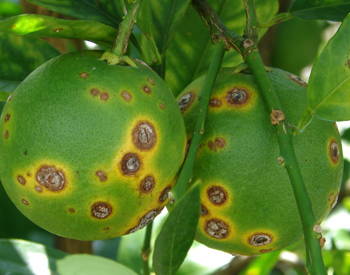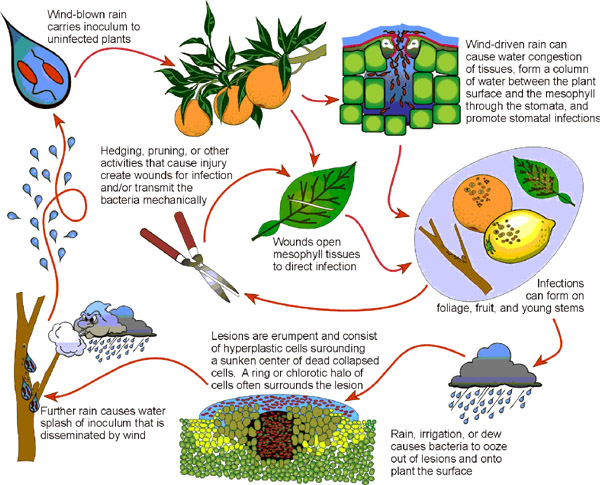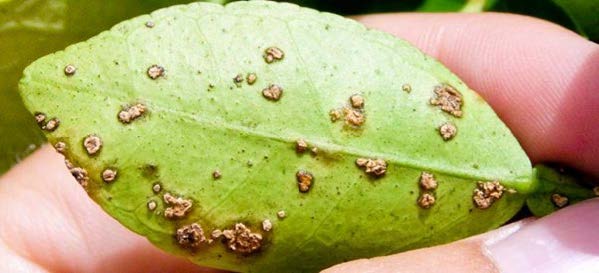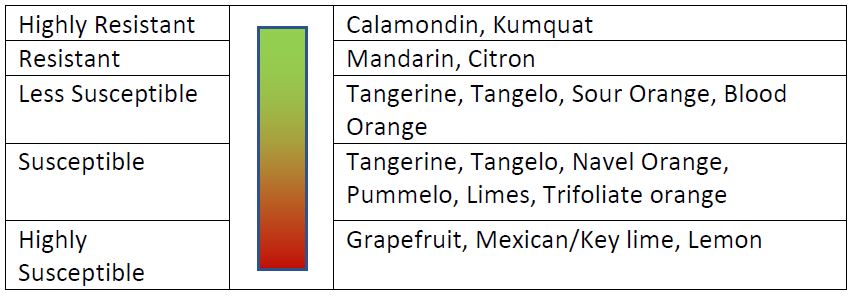Citrus Canker Pest Profile
Pest Profile

Description
Citrus canker is a disease caused by the bacterium Xanthomonas citri ssp. citri, a rod-shaped gram-negative bacterium with a single flagellum. Using films of water, the bacteria ‘swims’ through openings on leaves, stems and fruit of citrus hosts, multiplying, and causing necrotic lesions on leaves, stems, and fruit of susceptible hosts. Severe disease can cause defoliation, premature fruit drop, twig dieback, general tree decline, and significant blemishes on fruit. Trees infected with canker become weak and unproductive. There are different variants of the bacterium, the most common being Asiatic citrus canker, Xanthomonas citri ssp. citri (Canker A).

(Source: Tim R. Gottwald, USDA)
History
Originally from Southeast Asia, citrus canker is primarily established in countries with tropical and subtropical climates. In the United States, citrus canker was first found near the Florida-Georgia border in 1910, where it was considered eradicated by 1933 after an extensive culling of thousands of citrus hosts. In 1986, canker reemerged on residential citrus in Florida and then spread to commercial citrus groves. After a vigorous eradication program, it was again declared eradicated in 1994. Canker was rediscovered in Miami-Dade County in Florida in 1995, and despite a 10-year effort to eradicate the disease, eradication ended in early 2006 due to program challenges and hurricanes spreading the disease over large areas. Efforts are now focused on management and containment of canker, and protection of nursery stock.
Distribution
Asiatic citrus canker is established in various citrus-producing countries, including many in Southeast Asia, Africa, Australia, Brazil, the Middle East, and the United States. In addition to establishment in Florida, there have been finds in Louisiana and Texas in 2014 and 2016, respectively. The disease is not known to be in California. There is no record of seed transmission of citrus canker, and an introduction to California would most likely occur through improper movement of infected host material.
Citrus canker has three major variants: Canker A, Cancrosis B and Cancrosis C. Each variant is differentiated by geographical distribution and host susceptibility.
Canker A (caused by X. citri ssp. citri) is the Asiatic form of the bacterium and the most destructive. It infects most of the major citrus cultivars and can lead to defoliation, severe fruit blemishes, dieback, reduced fruit quality, and premature fruit drop. Canker A can be found in Asia, Africa, South America, and parts of the United States. It affects all citrus hosts, the most susceptible being grapefruit.
Cancrosis B caused by a different subspecies called aurantifolii affects lemon, Mexican lime, sour orange, and pummelo. It causes symptoms like Canker A, but lesions are smaller and through testing shows slower bacterial growth. Cancrosis B has mainly been found in Paraguay, Uruguay, Argentina, and Brazil.
Cancrosis C also caused by subspecies aurantifolii was primarily found on Mexican lime and produces the same smaller lesions as Cancrosis B. Cancrosis C was primarily found in Brazil.
Cancrosis B and C exist primarily in laboratory collections and may not be easily found in the environment today. This seems to be because Canker A is more aggressive and quickly dominates in areas where it has been introduced accidentally.
Symptoms
Citrus canker causes lesions that are visible on citrus leaves, stems, and fruit. Lesions appear as brown spots on the upper and lower side of leaves, are oily in appearance, and surrounded by a yellow halo. As the disease progresses, lesions become corky and may manifest a crater-like depression the center. Infected citrus trees can experience early leaf fall. The lesions on fruit and stems are like those found on leaves. Infected fruit may drop prematurely and is susceptible to secondary infection by other organisms. Severe infection can also cause shoot dieback and defoliation. The bacterium can survive for long periods of time in diseased tissues that includes the discoloration of tree bark on trunks and limbs.
Citrus canker is primarily spread short distances through high wind and rain, water splash, and may be assisted by irrigation systems. Citrus leafminer larvae can also aid in spreading citrus canker by exposing internal plant tissue. Infected plants and plant parts (budwood and rootstock seedlings) are the primary source of long-distance spread. The bacterium swims through any openings in leaves and newly growing shoots ranging from natural openings (such as leaf stomata) or unnatural openings (such as insect wounds or wounds caused by pruning). Citrus leafminer is widely established in California. The most critical time for fruit infection is usually 90 days after petal fall where the bacterium will remain in the infected hosts until leaves and fruits fall.

(Photo credit: M. Dewdney)

(Photo credit: USDA)
Hosts
Citrus canker can be found on numerous species of citrus and their hybrids. Hosts that are highly susceptible to the disease are grapefruit, Mexican lime, sweet lime, lemon, and trifoliate orange. Three citrus varieties knowns to show resistance to the bacteria are kumquat, calamondin, and citron.

Damage and Economic Importance
Millions of dollars are spent annually worldwide on prevention, quarantines, eradication, and control for citrus canker. Potential costs to California include the eradication and/or management of the disease, and the economic fallout from the destruction of trees, including costs incurred from tree removal and lost revenue from quarantine implementation and regulation. An introduction of citrus canker in California would prove devasting to California’s citrus industry, which was valued at $3.389 billion in 2017. This disease cost Florida more than $6 million from 1915-1933. The destruction of over 20 million citrus trees in the 1980’s cost Florida $94 million in lost revenue. In 2006, Florida’s citrus canker eradication program cost nearly $1 billion.
Sources
- https://www.citrusalert.com/438-2/
- https://www.aphis.usda.gov/aphis/ourfocus/planthealth/plant-pest-and-disease-programs/pests-and-diseases/citrus/citrus-canker
- https://www.apsnet.org/edcenter/disandpath/prokaryote/pdlessons/Pages/CitrusCanker.aspx
- https://www.apsnet.org/edcenter/apsnetfeatures/Article%20Images/CitrusCanker_Fig12.jpg
- https://www.fdacs.gov/content/download/11383/file/ppcirc377-rev5.pdf
- https://edis.ifas.ufl.edu/pp116
- https://cisr.ucr.edu/invasive-species/asiatic-citrus-canker
- https://aic.ucdavis.edu/research1/citruscanker.pdf
- http://www.plantmanagementnetwork.org/pub/php/review/citruscanker/
- https://citrusresearch.org/wp-content/uploads/Economic-Contribution-of-California-Citrus-Industry21.pdf
- https://www.dpi.nsw.gov.au/biosecurity/plant/insect-pests-and-plant-diseases/citrus-canker#:~:text=Citrus%20canker%20bacteria%20may%20survive,limbs%20and%20in%20plant %20debris
- https://www.pestnet.org/fact_sheets/citrus_canker_091.pdf
- http://www.b3.net.nz/gerda/refs/176.pdf
- https://anrcatalog.ucanr.edu/pdf/8218.pdf
